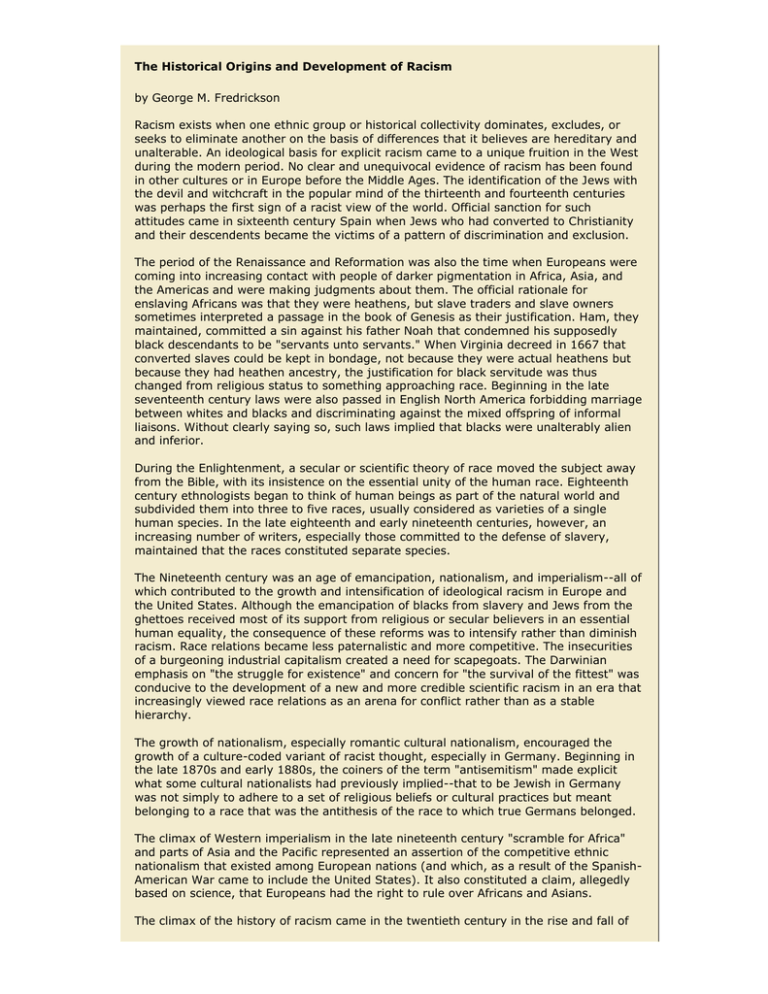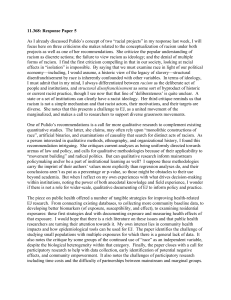
The Historical Origins and Development of Racism
by George M. Fredrickson
Racism exists when one ethnic group or historical collectivity dominates, excludes, or
seeks to eliminate another on the basis of differences that it believes are hereditary and
unalterable. An ideological basis for explicit racism came to a unique fruition in the West
during the modern period. No clear and unequivocal evidence of racism has been found
in other cultures or in Europe before the Middle Ages. The identification of the Jews with
the devil and witchcraft in the popular mind of the thirteenth and fourteenth centuries
was perhaps the first sign of a racist view of the world. Official sanction for such
attitudes came in sixteenth century Spain when Jews who had converted to Christianity
and their descendents became the victims of a pattern of discrimination and exclusion.
The period of the Renaissance and Reformation was also the time when Europeans were
coming into increasing contact with people of darker pigmentation in Africa, Asia, and
the Americas and were making judgments about them. The official rationale for
enslaving Africans was that they were heathens, but slave traders and slave owners
sometimes interpreted a passage in the book of Genesis as their justification. Ham, they
maintained, committed a sin against his father Noah that condemned his supposedly
black descendants to be "servants unto servants." When Virginia decreed in 1667 that
converted slaves could be kept in bondage, not because they were actual heathens but
because they had heathen ancestry, the justification for black servitude was thus
changed from religious status to something approaching race. Beginning in the late
seventeenth century laws were also passed in English North America forbidding marriage
between whites and blacks and discriminating against the mixed offspring of informal
liaisons. Without clearly saying so, such laws implied that blacks were unalterably alien
and inferior.
During the Enlightenment, a secular or scientific theory of race moved the subject away
from the Bible, with its insistence on the essential unity of the human race. Eighteenth
century ethnologists began to think of human beings as part of the natural world and
subdivided them into three to five races, usually considered as varieties of a single
human species. In the late eighteenth and early nineteenth centuries, however, an
increasing number of writers, especially those committed to the defense of slavery,
maintained that the races constituted separate species.
The Nineteenth century was an age of emancipation, nationalism, and imperialism--all of
which contributed to the growth and intensification of ideological racism in Europe and
the United States. Although the emancipation of blacks from slavery and Jews from the
ghettoes received most of its support from religious or secular believers in an essential
human equality, the consequence of these reforms was to intensify rather than diminish
racism. Race relations became less paternalistic and more competitive. The insecurities
of a burgeoning industrial capitalism created a need for scapegoats. The Darwinian
emphasis on "the struggle for existence" and concern for "the survival of the fittest" was
conducive to the development of a new and more credible scientific racism in an era that
increasingly viewed race relations as an arena for conflict rather than as a stable
hierarchy.
The growth of nationalism, especially romantic cultural nationalism, encouraged the
growth of a culture-coded variant of racist thought, especially in Germany. Beginning in
the late 1870s and early 1880s, the coiners of the term "antisemitism" made explicit
what some cultural nationalists had previously implied--that to be Jewish in Germany
was not simply to adhere to a set of religious beliefs or cultural practices but meant
belonging to a race that was the antithesis of the race to which true Germans belonged.
The climax of Western imperialism in the late nineteenth century "scramble for Africa"
and parts of Asia and the Pacific represented an assertion of the competitive ethnic
nationalism that existed among European nations (and which, as a result of the SpanishAmerican War came to include the United States). It also constituted a claim, allegedly
based on science, that Europeans had the right to rule over Africans and Asians.
The climax of the history of racism came in the twentieth century in the rise and fall of
what might be called overtly racist regimes. In the American South, the passage of racial
segregation laws and restrictions on black voting rights reduced African Americans to
lower caste status. Extreme racist propaganda, which represented black males as
ravening beasts lusting after white women, served to rationalize the practice of lynching.
A key feature of the racist regime maintained by state law in the South was a fear of
sexual contamination through rape or intermarriage, which led to efforts to prevent the
conjugal union of whites with those with any known or discernable African ancestry.
Racist ideology was eventually of course carried to its extreme in Nazi Germany. It took
Hitler and his cohorts to attempt the extermination of an entire ethnic group on the basis
of a racist ideology. Hitler, it has been said, gave racism a bad name. The moral
revulsion of people throughout the world against what the Nazis did, reinforced by
scientific studies undermining racist genetics (or eugenics), served to discredit the
scientific racism that had been respectable and influential in the United States and
Europe before the Second World War.
Explicit racism also came under devastating attack from the new nations resulting from
the decolonization of Africa and Asia and their representatives in the United Nations. The
Civil Rights movement in the United States, which succeeded in outlawing legalized racial
segregation and discrimination in the 1960s drew crucial support from the growing sense
that national interests were threatened when blacks in the United States were
mistreated and abused. In the competition with the Soviet Union for "the hearts and
minds" of independent Africans and Asians, Jim Crow and the ideology that sustained it
became a national embarrassment with possible strategic consequences.
The one racist regime that survived the Second World War and the Cold War was the
South African in 1948. The laws passed banning all marriage and sexual relations
between different "population groups" and requiring separate residential areas for people
of mixed race ("Coloreds"), as well as for Africans, signified the same obsession with
"race purity" that characterized the other racist regimes. However the climate of world
opinion in the wake of the Holocaust induced apologists for apartheid to avoid, for the
most part, straightforward biological racism and rest their case for "separate
development" mainly on cultural rather than physical differences.
The defeat of Nazi Germany, the desegregation of the American South in the 1960s, and
the establishment of majority rule in South Africa suggest that regimes based on
biological racism or its cultural essentialist equivalent are a thing of the past. But racism
does not require the full and explicit support of the state and the law. Nor does it require
an ideology centered on the concept of biological inequality. Discrimination by
institutions and individuals against those perceived as racially different can long persist
and even flourish under the illusion of non-racism, as historians of Brazil have recently
discovered. The use of allegedly deep-seated cultural differences as a justification for
hostility and discrimination against newcomers from the Third World in several European
countries has led to allegations of a new "cultural racism." Recent examples of a
functionally racist cultural determinism are not in fact unprecedented. They rather
represent a reversion to the way that the differences between groups could be made to
seem indelible and unbridgeable before the articulation of a scientific or naturalistic
conception of race in the eighteenth century.
George M. Fredrickson is Edgar E. Robinson Professor Emeritus of United States History
at Stanford University.
© 2003 California Newsreel. All rights reserved.






